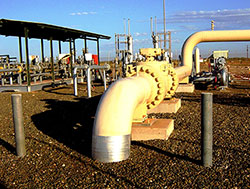Instrument Gas Dryers: Solutions for Removing Water Vapor from Natural Gas

Instrument gas is used to operate surface equipment and pneumatic controls near the wellhead and other locations along the transmission system, usually where a source of instrument air and electric power are not available. Instrument gas dryers are used to remove water vapor from natural gas (instrument gas) to prevent liquid water and/or ice from forming in the gas lines.
These Instrument Gas dryers (Dehydrators) are very effective in the Natural Gas Fields and recently in the Shale Gas fields. They have been very effective on separator pads controlling valves and on compressor station instrumentation. These remote applications are ideal for Instrument Gas dryers.
Why Instrument Gas must be dried?
- Natural gas leaves the well saturated with water vapor
- The water vapor can condense in the piping and cause damage to the pneumatic controls and freeze-ups in the instrument gas lines
- The damaged equipment and frozen instrument gas lines can lead to gas wells and pipelines being shut down for equipment repairs
Advantages of Instrument Gas Dryers
- Require no utilities
- Produce no BTEX or VOC emissions
- Require very little operator training
- Prevent lost production during colder months due to frozen valves, actuators or float controls
- Only affect the water content, not the hydrocarbon content of the gas
Deliquescent Dryers (PLD Series & D Series)
- Pipeline Dryers (PLD) where the units are manufactured in 280, 720 and 1450 psig models
- Small Single-Tower Deliquescent Dryers (D Series) are often used in these applications and are capable of operating pressure up to 250 psig
- The deliquescent dryer is installed in the gas line from the production separator leading to the pneumatic equipment
- The gas flows through the deliquescent dryer and removes the water vapor
- The desiccant gradually dissolves as it removes the water vapor, and must be periodically added
- The removed water and dissolved desiccant solution accumulates in the dryer vessel and is drained away
- No electric power is required for deliquescent dryers
- Used to prevent water condensation in gas lines (0 to 1450 PSIG)
- PLD Gas Dryer Brochure
- Small Single-Tower Deliquescent Dryers (D Series) Brochure
Inline Adsorbent Desiccant Dryers (ID Series)
- Small in-line dryers using adsorbent desiccant can also be used to provide even dryer gas for critical applications
- This desiccant provides a dew point of -40°F or lower in the instrument gas
- The desiccant eventually is saturated and must be replaced
- These dryers produce no liquids to dispose of
- No power is required to operate in-line adsorbent dryers
- Used at point-of-use where very low dew points (-40°F) are required (0 to 250 PSIG)
- See Non-Regenerative Cartridge Type Air Dryers for more details
- ID Series In-line Desiccant Dryers Brochure
Regenerative Desiccant Dryers (HLSXG Series)
- In some installations, regenerative desiccant dryers can be used
- Electric power is required, either AC power or DC power
- Regenerative desiccant dryers provide a continuous water dew point of -40°F or lower in the instrument gas, with no desiccant re-fill requirements
- These dryers will vent purge gas, so purge gas must be vented to flare or vapor recovery
- Used where very low dew points (-40°F) are required, and where electric power is available (80 to 250 PSIG)
- See Natural Gas Regenerative Dryers for more details
- HLSX Dryer Brochure
FREE cost analysis of natural gas dryers
Air & Vacuum Process (AVP) has extensive knowledge about Instrument Gas Dryer applications. Let us do a FREE cost analysis to help you make a more informed buying decision. Just call 866.660.0208 or email sales@airvacuumprocess.com to get started.